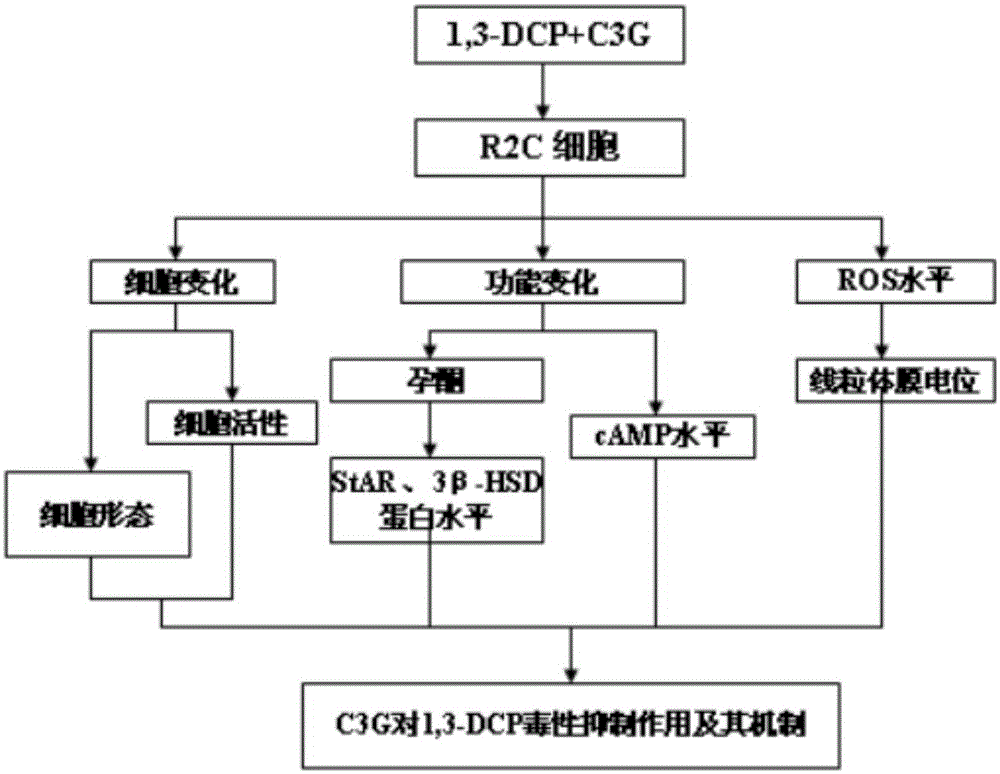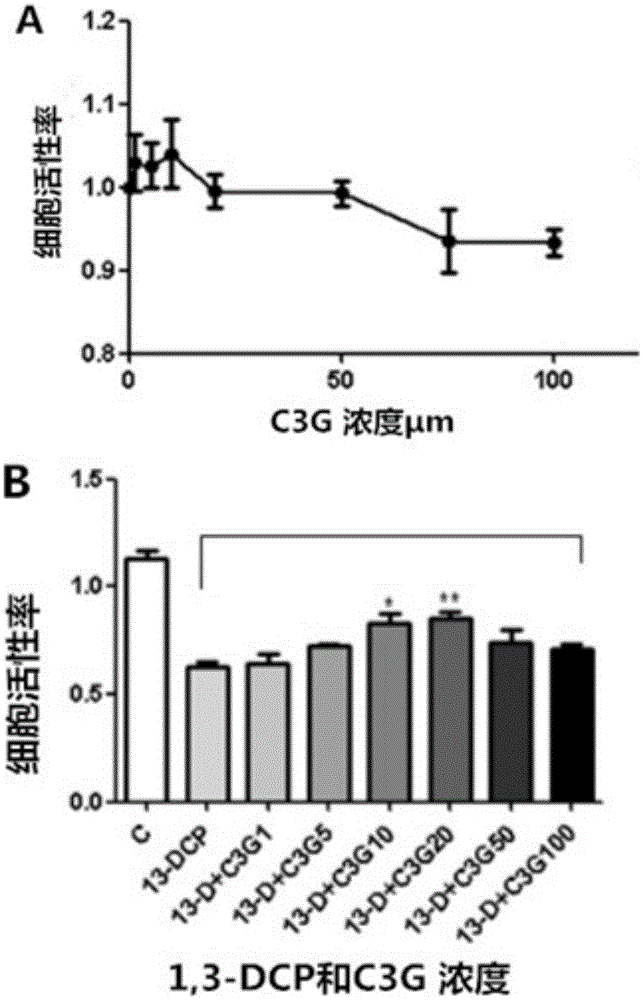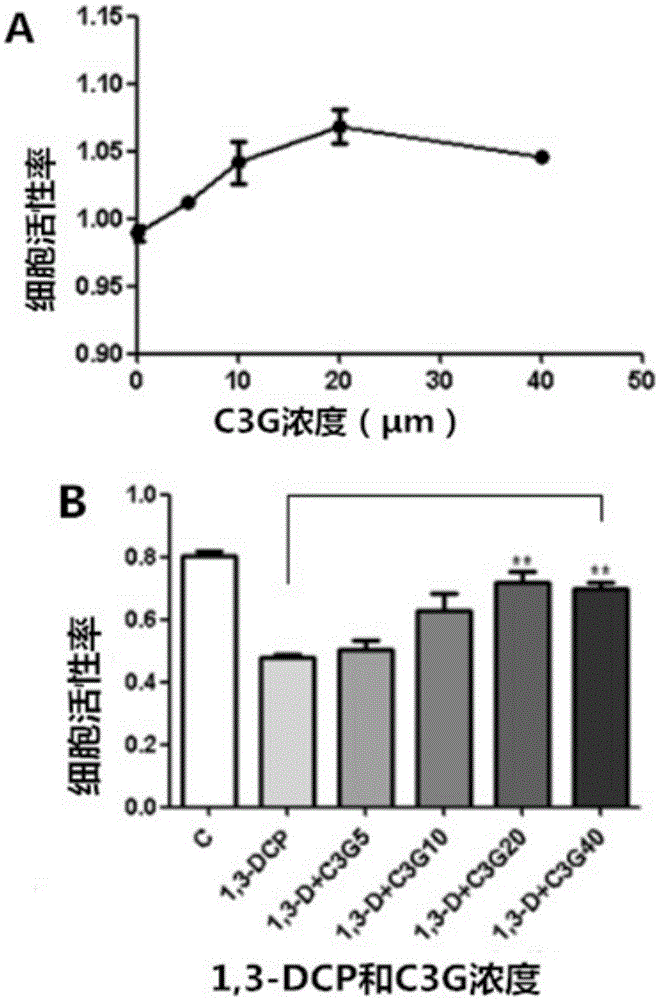Interventional effect of cyanidin-3-O-glucoside on reproductive toxicity of 1,3-dichloro-2-propanol
A technology of glucoside and cyanidin, applied in the field of medicine, can solve problems such as hazards, life-threatening, and weight loss of organisms, and achieve significant research results
- Summary
- Abstract
- Description
- Claims
- Application Information
AI Technical Summary
Problems solved by technology
Method used
Image
Examples
Embodiment 1
[0038] Example 1 MTT method to screen the concentration of 1,3-DCP on R2C cells and the concentration of C3G intervention
[0039] 1. MTT method to screen the concentration of 1,3-DCP on R2C cells
[0040] (1) Experimental method
[0041] 1) Cells were cultured to the logarithmic phase, digested with trypsin, centrifuged at 1500r / min for 5min, and diluted to 4×10 4 cells / mL, spread on a 96-well plate, and add about 200 μL of suspension to each well;
[0042] 2) After 24 hours, add different concentrations of 1,3-DCP to the corresponding groups, the concentration of each group is 1, 2, 4, 6, 8 mmol / L, 5 replicate wells in each group, and each group is repeated 3 times , and set a cell-free blank group;
[0043] 3) After 24 hours, absorb the liquid, add 10 μL of 5 mg / mL MTT reagent to each well, and place in a 37°C incubator;
[0044] 4) After 4 hours of MTT action, remove the liquid in the well and replace it with 200 μL of DMSO reagent, place the 96-well plate on a shake...
Embodiment 2
[0055] Embodiment 2 MTT method measures the inhibitory effect of C3G on 1,3-DCP in terms of cell activity
[0056] 1. Experimental method
[0057] (1) Cell culture and seeding Cell culture to the logarithmic phase, digest with trypsin, centrifuge at 1500r / min for 5min, and dilute the precipitate to 4×10 4 cells / mL, spread on a 96-well plate, and add about 200 μL of suspension to each well.
[0058] (2) 24 hours after inoculating cells in a 96-well plate, add C3G solution diluted with F12 culture medium (except the control group) to the corresponding groups in one of the 96-well plates, so that the final concentration of C3G in each well of each group is 5, 10, 20, 40 μmol / L. Add C3G solution and 1,3-DCP solution diluted in F12 culture medium to another 96-well plate, except for the control group, make the C3G in other groups be 5, 10, 20, 40 μmol / L respectively, 1,3-DCP in each well of each group The concentration of 3-DCP is 2mmol / L. The settings of the duplicate wells ...
Embodiment 3
[0063] Example 3 Intervention of C3G on morphological changes of R2C cells caused by 1,3-DCP detected by fluorescence microscopy
[0064] 1. Experimental method
[0065] (1) After resuspending the logarithmic phase cells and diluting the cells, inoculate 1 mL (approximately 20,000 cells) in each well of a 6-well plate.
[0066] (2) After 24 hours, add C3G solution and 1,3-DCP solution diluted with F12, except the first group, so that the C3G added in each well of each group is 5, 10, 20, 40 μmol / L, each group The 1,3-DCP concentration of the wells was 2 mmol / L.
[0067] (3) Stimulate each concentration of C3G and 1,3-DCP for 24 hours, check the cell morphology with a fluorescence microscope and take pictures.
[0068] 2. Observation of cell morphology by fluorescence microscope Figure 4 shown. The results showed that, compared with the cells in the control group, under the action of 2 mmol / L 1,3-DCP, the shape of R2C cells was significantly smaller and the number of cel...
PUM
 Login to View More
Login to View More Abstract
Description
Claims
Application Information
 Login to View More
Login to View More - R&D
- Intellectual Property
- Life Sciences
- Materials
- Tech Scout
- Unparalleled Data Quality
- Higher Quality Content
- 60% Fewer Hallucinations
Browse by: Latest US Patents, China's latest patents, Technical Efficacy Thesaurus, Application Domain, Technology Topic, Popular Technical Reports.
© 2025 PatSnap. All rights reserved.Legal|Privacy policy|Modern Slavery Act Transparency Statement|Sitemap|About US| Contact US: help@patsnap.com



